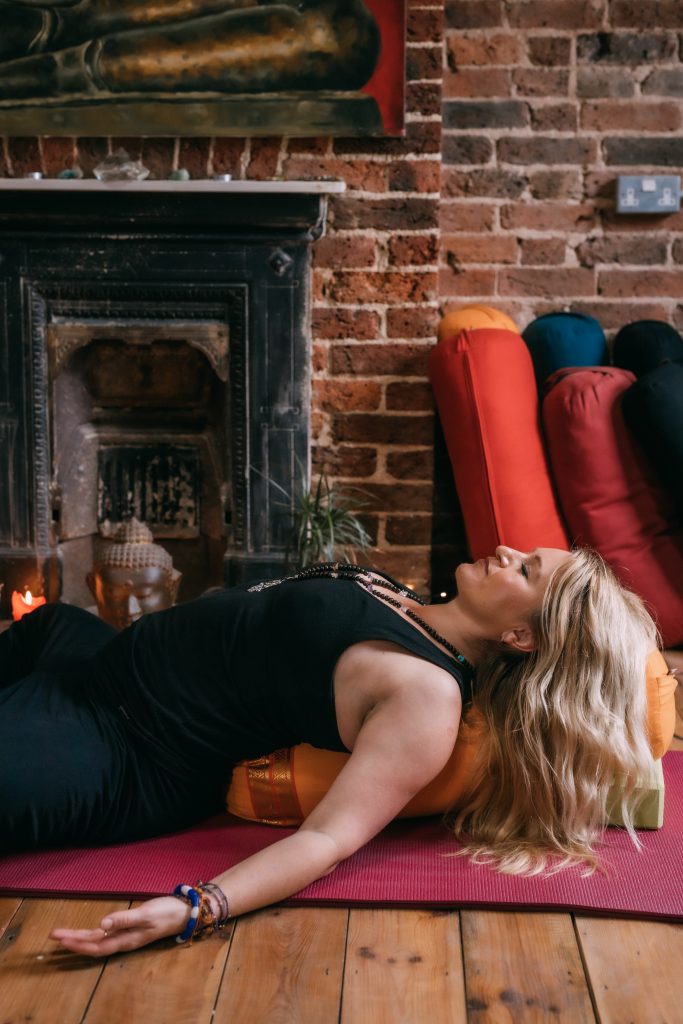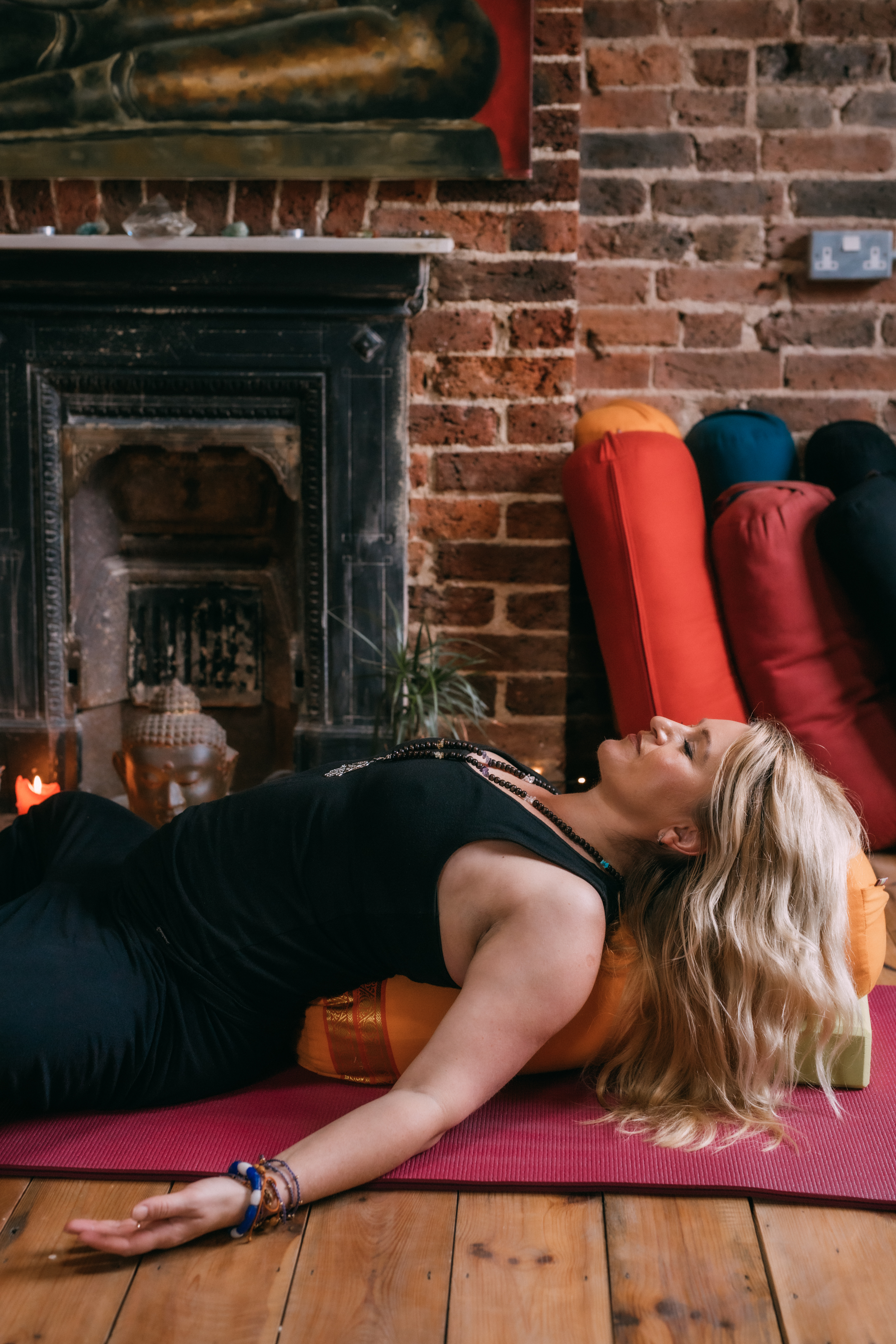What is Yoga Nidra and how it works? – By Eva Kristlova of Yoga Life Studio
Yoga Nidra is a form of guided meditation also known as “yogic sleep” or “effortless relaxation”. It is practiced in a comfortable position lying down in Savasana, with a teacher guiding the session. The practice draws our attention inwards, where we move between the states of wakefulness and sleep, where our body finds its natural state of equilibrium. The breath softens, balances and becomes more rhythmical; the mind becomes quieter, and we fall into an innate state of deep, blissful awareness and relaxation.
Yoga Nidra takes us effortlessly into a state of harmonious, restful being. From here, we can heal, restore and connect with our true self. This deeply nourishing practice is becoming increasingly popular and ongoing research continues to prove its effectiveness.
When you start Yoga Nidra, your brain is generally in an active state of beta waves, a natural transitional experience as you start to slow down and press pause on your day. The meditative practice then takes you into an alpha state, the brain wave frequency that links conscious thought with the subconscious mind.
So what is going on in your brain while you are practicing Yoga Nidra and why it leaves you so refreshed, like you had the best nap of your life?
During yoga nidra practice you are prompted to feel your body and your breath using a specific technique that takes you out of “fight and flight” state and triggers the relaxation response.
The parasympathetic nervous system is activated and this shift to restful mode aligns the activity of your right and left brain hemispheres.
In the process, your brain shifts from beta brain waves (state of awakening with lots of brain activity), to alpha brain waves (a more relaxed state which is associated with sitting in a relaxed position with eyes closed)
In alpha, the mood-enhancing hormone serotonin gets released, and brings about a feeling of calm. As you move into alpha-state, you are slowing down the brain activity and beginning to shift into a state of rest.
From alpha, you continue to transition into a deep alpha and theta brain-wave state, which is also referred to as “the dream state”, or REM state. Your thoughts slow down even more. This is a state where we process our emotions, and release the ones that no longer serve us.
After theta, you dive into blissful delta brain wave state. Your thoughts continue to slow down. This is the most restorative and restful state, in which your organs regenerate and the body metabolises cortisol – the stress hormone, and moves it out of your system.
Very few of us get enough delta-quality rest on a regular basis, which is why adding Yoga Nidra to your self-care practice is so important.
I have been delivering delicious Yoga Nidra classes in Eastbourne and online and the feedback is always incredible, with everyone reporting many benefits such as improved sleep, pain relief, total rejuvenation, clarity of mind, relaxation of the nervous and muscular system to name just a few.
Here is a little Yoga Nidra practice for you to try (it is best if someone reads it to you in a slow, soft voice):
Make yourself comfortable, lying on your back with the knees slightly bent and supported. Make sure that you are warm enough and make any adjustments to find a comfortable position. If possible, remain still during Yoga Nidra so that both your body and brain have a chance to fully relax. Allow your eyes to gently close. The practice of yoga nidra is a practice of yogic sleep, a state of consciousness between wakefulness and sleeping.
Become aware of your body gently sinking into your mat or any other surface underneath you. Allow your body to become heavy and fully supported, knowing that you are giving yourself time to reset and restore, there is nothing else you need to do. This is your time to pause and relax.
Become aware of your natural breath, the breath that moves in and out of your nose without any effort. Notice the feeling of the breath as it comes in and out of your nostrils. There is a sense of coolness as you inhale the breath. And there is a sense of warmth as you exhale the breath. Feel this warmth on your upper lip as you breathe out. Allow your breath to become longer and slower. Take a long slow inhalation, followed by a longer slower exhalation. Make your exhale even slower – notice the slight pause after the exhale. Slow inhale, even slower exhale, and pause. slow inhale, longer slower exhale, and then pause where the body is neither breathing in nor out. Continue to breathe in this way for a few more rounds. Now go back to the natural easy breath, releasing any control over the inhale or exhale.
We will now begin a systematic journey of sensory awareness throughout the body. You will move your awareness to different parts of your body as soon as you hear them named. The practice begins on the right side. Right hand thumb … 2nd finger … 3rd finger … 4th finger … 5th finger … palm of the hand … back of the hand … wrist … forearm … elbow … upper arm … shoulder … armpit … waist … hip … thigh … knee … calf … ankle … heel … sole of the foot … top of the foot … right big toe … 2nd toe … 3rd toe … 4th toe … 5th toe. Left hand thumb … 2nd finger … 3rd finger … 4th finger … 5th finger … palm of the hand … back of the hand … wrist … forearm … elbow … upper arm … shoulder … armpit … waist … hip … thigh … knee … calf … ankle … heel … sole of the foot … top of the foot … left big toe … 2nd toe … 3rd toe … 4th toe … 5th toe.
Now go to the back of the body … right heel … left heel … right calf … left calf … right thigh … left thigh … right buttock … left buttock … lower back … middle back … upper back … the entire spine … right shoulder blade … left shoulder blade … back of the neck … back of the head. Top of the head … forehead … right temple … left temple … right ear … left ear … right eyebrow … left eyebrow … middle of the eyebrows … right eye … left eye … right nostril … left nostril … right cheek … left cheek … upper lip … lower lip … both lip together … chin … jaw … throat … right collarbone … left collarbone … right side of the chest … left side of the chest … upper abdomen … navel … lower abdomen … right hip … left hip … the pelvis. The whole right leg … whole left leg … whole right arm … whole left arm … the whole face … the whole head … the whole torso … the whole body … the whole body … the whole body.
Now imagine your body becoming heavy. Feel the heaviness in all parts of the body, each part is becoming heavier and heavier and heavier. The head is heavy, the limbs are heavy, the torso is heavy, the whole body is heavy. So heavy that it is sinking down into the floor. Heavy and relaxed.
Now imagine the whole body becoming light. As though your body could float away from the floor and toward the ceiling. The head is light and weightless, the limbs are light and weightless, the torso is light and weightless, the whole body light and weightless. You are rising higher and higher away from the floor. You are completely relaxed.
Now, I will list a few objects and as I name each one, try to visualise them in your mind. Let the images come to you as you focus on the space between your eyebrows.
Pink rose, waves on the ocean, blue sky in the evening, dark night, tiny shining stars, high mountain with a snow-capped peak, a ship sailing on the sea, white sandy beach, a dove, a wild horse, full moon, big garden of blooming flowers, rising sun.
Large lake of lotus flowers, beautiful sunset, calm and quiet evening in a moonlit valley, mountain stream, white fluffy clouds in the sky, fog all around you, pink rose, sunflower, tall pine tree, symbol of OM, sound of a bell ringing, lotus on a lake, moonlit valley.
Slowly come back to your breath flowing in and out of your nostrils. Maintain your awareness of breath and at the same time develop your awareness of your physical body. Your body is relaxed and lying on the floor. Notice the heaviness of your body as it rests on the floor and take your awareness into all the points that are touching the floor; the back of your heels, thighs, buttocks, shoulder blades, arms, hands and head. Do not open your eyes yet but visualize the surrounding room. Imagine where you are in the room and the other objects that are around you. Lie quietly until you feel ready to move. Start by slowly moving your hands and feet, take your time, there is no hurry. When you are sure that you are fully awake, gently open your eyes. Please roll over to your right side and stay there for a moment. When you are ready to come slowly make your way into sitting. The practice of yoga nidra is now complete.
Eva Kristlova runs Yoga Nidra classes in the Yoga Life Studio in Eastbourne and online every Thursday at 4pm.


